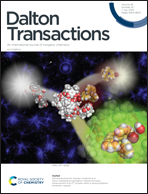Diversity and uniformity in anion–π complexes of thiocyanate with aromatic, olefinic and quinoidal π-acceptors†
Abstract
Despite the progress in the study of anion–π interactions, there are still inconsistencies in the use of this term and the experimental data about factors affecting the strength of such bonding are limited. To shed light on these issues, we explored supramolecular associations between NCS− anions and a series of aromatic, olefinic or quinoidal π-acceptors. Combined experimental and computational studies revealed that all these complexes were formed by an attraction of the anion to the face of the π-system, and the arrangements of thiocyanate followed the areas of the most positive potentials on the surfaces of the π-acceptors. The stabilities of the complexes increased with the π-acceptor strength (reflected by their reduction potentials), and were essentially independent of the magnitudes of the maximum electrostatic potentials on their surfaces. The complexes showed intense absorption bands in the UV-Vis range, and the energies of these bands were correlated with the difference of the redox potentials of the anions and π-acceptors. Such features, as well as results of atoms-in-molecules and non-covalent index analyses suggested that besides electrostatics, molecular orbital interactions play a substantial role in the formation of these complexes. The unified trends in variations of the characteristics of the complexes between thiocyanate and a variety of π-acceptors point to their common nature. To embrace diversity and uniformity of the anion–π associates, we suggest (following the halogen bond's definition) that anion–π bonding occurs when there is evidence of a net attraction between the anions and the face of the electrophilic π-system.



 Please wait while we load your content...
Please wait while we load your content...